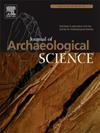50 years of bronze provenance studies: A perspective from China
IF 2.5
1区 地球科学
Q1 ANTHROPOLOGY
引用次数: 0
Abstract
This review summarizes the current state of bronze provenance studies in China, highlighting both recent trends and challenges for scholars working with Chinese artefacts and beyond. The first section addresses the issues surrounding highly radiogenic lead (HRL) from the Shang period, arguably the most widely discussed topic in Chinese bronze provenance research. In addition to providing an overview of the current discourse, this section emphasizes two critical questions: the metal(s) with which HRL is associated, and the meaning of its isochron-like trend line. Clarifying these questions could fundamentally alter our understanding of HRL and the metal circulation systems of the Shang period. The second section focuses on the emerging pattern in the rapidly growing body of publications on lead isotope analysis of Chinese bronzes, particularly the synchronic alteration of lead isotope features across vast regions over two millennia. Additionally, this section reviews specific spatial-temporal units, which have generated significant research in recent years and may reveal distinct metal circulation systems. The following sections shift attention to the provenance of copper and tin, essential components in the production of bronze artefacts but often overlooked in provenance studies. Methodological challenges are discussed, with a particular emphasis on the widely used trace element analysis technique. Furthermore, increasing archaeological evidence from metallurgical workshops related to mining, smelting, and alloying practices of these metals holds potential to shed new light on these issues in the near future. Finally, the review offers a brief discussion on model-informed provenance investigations, reflecting a global trend in the field, which is expected to have a substantial impact on the study of Chinese materials in various ways.
50年青铜器来源研究:来自中国的视角
本文总结了中国青铜器来源研究的现状,强调了研究中国文物及其他国家的学者面临的最新趋势和挑战。第一部分讨论了商代高放射性成因铅(HRL)的相关问题,这可以说是中国青铜器来源研究中讨论最广泛的话题。除了概述当前的论述外,本节还强调了两个关键问题:与HRL相关的金属,以及它的等时线趋势线的意义。澄清这些问题可以从根本上改变我们对HRL和商代金属流通系统的认识。第二部分重点介绍了中国青铜器铅同位素分析出版物中快速增长的新模式,特别是两千年来铅同位素特征在广大地区的同步变化。此外,本节回顾了特定的时空单位,这些单位近年来产生了重要的研究,并可能揭示不同的金属循环系统。以下部分将注意力转移到铜和锡的来源,这是青铜器工艺品生产的重要组成部分,但在来源研究中经常被忽视。讨论了方法上的挑战,特别强调了广泛使用的微量元素分析技术。此外,来自冶金车间的越来越多的考古证据与这些金属的采矿、冶炼和合金化实践有关,这有可能在不久的将来为这些问题提供新的线索。最后,本文简要讨论了基于模型的物源调查,这反映了该领域的全球趋势,预计将对中国材料的研究在各个方面产生重大影响。
本文章由计算机程序翻译,如有差异,请以英文原文为准。
求助全文
约1分钟内获得全文
求助全文
来源期刊

Journal of Archaeological Science
地学-地球科学综合
CiteScore
6.10
自引率
7.10%
发文量
112
审稿时长
49 days
期刊介绍:
The Journal of Archaeological Science is aimed at archaeologists and scientists with particular interests in advancing the development and application of scientific techniques and methodologies to all areas of archaeology. This established monthly journal publishes focus articles, original research papers and major review articles, of wide archaeological significance. The journal provides an international forum for archaeologists and scientists from widely different scientific backgrounds who share a common interest in developing and applying scientific methods to inform major debates through improving the quality and reliability of scientific information derived from archaeological research.
 求助内容:
求助内容: 应助结果提醒方式:
应助结果提醒方式:


